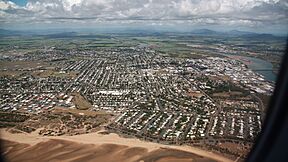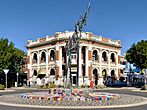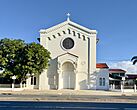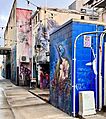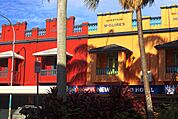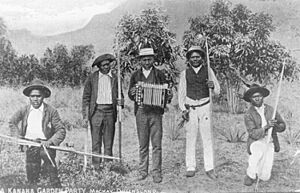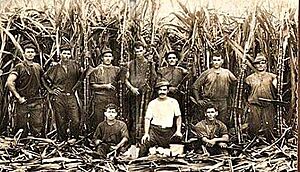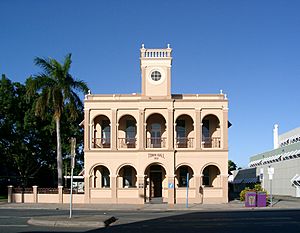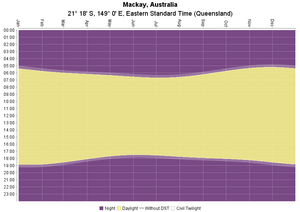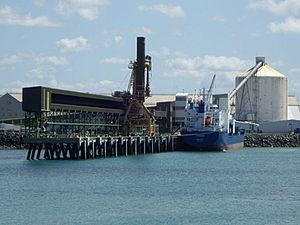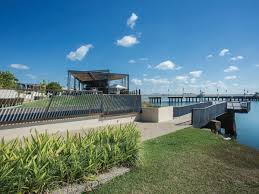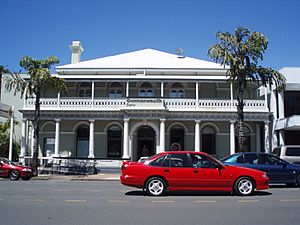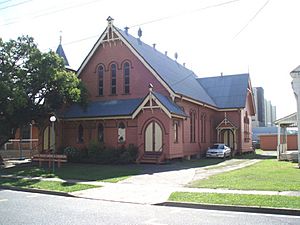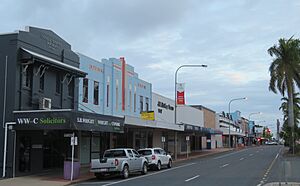Mackay, Queensland facts for kids
Quick facts for kids MackayQueensland |
|||||||||
|---|---|---|---|---|---|---|---|---|---|
|
Aerial view of Mackay, 2009
The Cane Fire sculpture
Street art down Fifth Lane
Spanish Mission architecture along Wood Street
Bluewater Sculpture trail
Mackay Harbour
|
|||||||||
| Population | 84,333 (2021) (22nd) | ||||||||
| • Density | 397.05/km2 (1,028.4/sq mi) | ||||||||
| Established | 1862 | ||||||||
| Postcode(s) | 4740 | ||||||||
| Elevation | 11.0 m (36 ft) | ||||||||
| Area | 212.4 km2 (82.0 sq mi)(2021 urban) | ||||||||
| Time zone | AEST (UTC+10:00) | ||||||||
| Location |
|
||||||||
| LGA(s) | Mackay Region | ||||||||
| State electorate(s) |
|
||||||||
| Federal Division(s) | |||||||||
|
|||||||||
Mackay (/məˈkaɪ/) is a city in Queensland, Australia. It is located on the eastern coast, near the Coral Sea. The city is about 970 kilometers (600 miles) north of Brisbane. It sits along the Pioneer River.
Mackay is often called the "Sugar Capital" because of its history with sugarcane. It was founded in 1862 and first named Alexandra. Later, it was renamed Mackay after John Mackay. The city's economy grew with sugar plantations. Many people from the South Sea Islands were brought to work there. Later, migrants from Italy and Malta also came to work on the sugarcane farms.
In 1918, a powerful cyclone almost destroyed Mackay. The city was rebuilt using Art Deco and Spanish Mission styles. These styles are still famous in Mackay today.
Mackay is known for its diverse culture and history. It has strong communities of Yuwi people, South Sea Islanders, Italians, Maltese, and Filipinos. The city is also famous for its seafood, tropical foods, public art, and jazz music. It hosts fun events like the Mackay Festival of Arts.
Some important places in Mackay include Bluewater Quay, Mackay Harbour, and the Bluewater Sculpture Trail. Nearby natural attractions are Eungella National Park, Cape Hillsborough, and the amazing Great Barrier Reef.
Contents
What's in a Name?
The city of Mackay is named after John Mackay. In 1860, he led a group of explorers into the Pioneer Valley. John Mackay wrote in his journal that his group found a large river. They decided to call it the Mackay River.
In 1862, John Mackay returned and started the first settlement. A town was soon built near the river's mouth. However, the river's name was changed to "Pioneer River" in December 1862. This was because there was already another "Mackay" River in Queensland.
In 1863, the town was surveyed. It was suggested to name it Alexandra, after Princess Alexandra of Denmark. She married Prince Edward, who later became King Edward VII. The name Alexandra is still used for a suburb in Mackay today.
Many people wonder how to say "Mackay." The correct way to pronounce it is "mə-KAI." This comes from the Gaelic name "MacAoidh."
A Look Back: Mackay's History
The land where Mackay now stands was first home to the local Yuibera people. Their language, Yuwibara, is an Indigenous language. It is spoken in the area that is now the Mackay Region.
Captain James Cook sailed past the Mackay coast in 1770. He named several places like Cape Palmerston and Cape Hillsborough. On this trip, the ship's botanist, Sir Joseph Banks, saw Indigenous Australians.
In 1860, John Mackay explored the region. He found the beautiful Pioneer Valley. Mackay was the first European to visit this area. He claimed large areas of land. In 1862, he returned with livestock to start cattle stations.
In 1863, Mackay became a port for new settlers. The first town lots were sold in 1864.
During the 1860s, the local Aboriginal people tried to protect their land. The Native Police patrolled the area. There were conflicts between the police and Aboriginal groups. Later, an Aboriginal Reserve was created near Rosella in 1871. This reserve closed in 1885.
In 1865, John Spiller planted the first sugarcane crop in Mackay. The first sugar mill was built in 1868. Many workers for the sugar plantations were South Sea Islanders. The first 70 of these workers arrived in Mackay in 1867. They were often brought to Australia against their will to work on the plantations.
By the mid-1880s, Mackay had over 30 sugar plantations. More than a third of the 6,000 residents were South Sea Islander workers. In 1883, a conflict happened between some of these workers and European settlers at the Mackay racecourse.
In 1918, Mackay was hit by a huge tropical cyclone. It caused a lot of damage and many lives were lost. The storm brought strong winds and a large storm surge. Communication with the outside world was cut off for five days. This cyclone was one of the most destructive to hit a populated area in Australia.
The Mackay War Memorial was first placed on the river bank in 1928. It was moved to Jubilee Park in 1945 due to flooding. It was moved again in 1973.
In 1943, a B17 aircraft crashed near Mackay. This was the largest loss of life in an Australian aircraft accident.
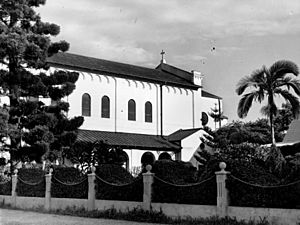
The Rats of Tobruk Memorial honors those who fought in the Battle of Tobruk. It was dedicated in 2001.
In 1958, Mackay experienced massive flooding. Over 878 mm (34.6 inches) of rain fell in 24 hours in Finch Hatton. The floodwaters reached 9.14 meters (30 feet) high in Mackay. Residents had to be rescued from rooftops.
In 1970, Queen Elizabeth II, the Duke of Edinburgh, and Princess Anne visited Mackay. They attended a special reception at the Anglican Parish Hall.
On February 15, 2008, Mackay was flooded again. Over 600 mm (23.6 inches) of rain fell in just 6 hours. About 2,000 homes were affected.
In 2010, Tropical Cyclone Ului hit the coast near Mackay. It was a strong Category 3 cyclone. Over 60,000 homes lost power, but no deaths were reported.
The Dudley Denny City Library opened in 2016. In the 2016 Census, the city of Mackay had a population of 78,685 people.
Historic Places in Mackay
Mackay has many heritage-listed sites. These are places that are important to the city's history. Some examples include:
- Mackay Technical College, Alfred Street
- World War I Cenotaph, Alfred Street
- Mackay Central State School, 251 Alfred Street
- Mackay General Cemetery, Cemetery Road
- Holy Trinity Church, 39 Gordon Street
- St Pauls Uniting Church, 21 MacAlister Street
- Mackay Memorial Swimming Centre, 2 Milton Street
- Mackay Customs House, 31 River Street
- Sugar Research Institute, 239 Nebo Road
- Mackay Town Hall, 63 Sydney Street
- Mackay Court House and Police Station, Victoria Street
- Commonwealth Bank Building, 63 Victoria Street
- Queensland National Bank, 79 Victoria Street
- Pioneer Shire Council Building, 1 Wood Street
- Mackay Masonic Temple, 57 Wood Street
Mackay's Geography

Mackay is located on the 21st parallel south. It is next to the Coral Sea coast. The city is built on both sides of the Pioneer River. To the west of the city are the Clarke Range mountains. Mackay is growing, with new areas being built in the Beachside, Southern, Central, and Pioneer Valley suburbs.
There is some discussion about whether Mackay is in North Queensland or Central Queensland. Government services for Mackay come from both Townsville (North Queensland) and Rockhampton (Central Queensland). However, the Australian Broadcasting Corporation (ABC) usually describes Mackay as being in North Queensland.
Mackay's Climate
Mackay has a warm climate with very rainy summers and mild, dry winters. This is called a humid subtropical climate. The weather is warm to hot all year. The average high temperature is about 30.5°C (87°F) in January. In July, it's about 22.8°C (73°F). The average low temperature is about 11.4°C (52.5°F) in July.
The wet season is from December to March. It brings hot weather, high humidity, and heavy rain. Sometimes, there are tropical cyclones. The dry season is from June to October. These months are cooler and less humid. They are usually sunny and dry. Frost is very rare in Mackay.
The hottest temperature ever recorded in Mackay was 39.7°C (103.5°F) in November 1918. The coldest was -0.4°C (31.3°F) in July 1951. The most rain in one day was 627.4 mm (24.7 inches) in January 1918.
| Climate data for Mackay Aero (21º10'12"S, 149º10'48"E, 5 m AMSL) (1950-2024 normals and extremes, sun 1983-2016) | |||||||||||||
|---|---|---|---|---|---|---|---|---|---|---|---|---|---|
| Month | Jan | Feb | Mar | Apr | May | Jun | Jul | Aug | Sep | Oct | Nov | Dec | Year |
| Record high °C (°F) | 36.9 (98.4) |
37.3 (99.1) |
35.4 (95.7) |
33.6 (92.5) |
31.4 (88.5) |
32.0 (89.6) |
30.1 (86.2) |
32.1 (89.8) |
35.4 (95.7) |
38.5 (101.3) |
39.7 (103.5) |
38.2 (100.8) |
39.7 (103.5) |
| Mean daily maximum °C (°F) | 30.5 (86.9) |
30.3 (86.5) |
29.5 (85.1) |
27.7 (81.9) |
25.3 (77.5) |
23.3 (73.9) |
22.8 (73.0) |
23.9 (75.0) |
26.1 (79.0) |
28.5 (83.3) |
29.7 (85.5) |
30.8 (87.4) |
27.4 (81.2) |
| Mean daily minimum °C (°F) | 23.1 (73.6) |
23.2 (73.8) |
22.2 (72.0) |
19.6 (67.3) |
15.8 (60.4) |
12.9 (55.2) |
11.4 (52.5) |
12.1 (53.8) |
14.9 (58.8) |
18.3 (64.9) |
20.6 (69.1) |
22.3 (72.1) |
18.0 (64.5) |
| Record low °C (°F) | 16.5 (61.7) |
18.0 (64.4) |
14.2 (57.6) |
7.8 (46.0) |
3.8 (38.8) |
1.7 (35.1) |
−0.4 (31.3) |
2.0 (35.6) |
4.7 (40.5) |
9.5 (49.1) |
12.8 (55.0) |
15.6 (60.1) |
−0.4 (31.3) |
| Average precipitation mm (inches) | 309.3 (12.18) |
322.7 (12.70) |
248.4 (9.78) |
164.7 (6.48) |
88.5 (3.48) |
57.6 (2.27) |
40.9 (1.61) |
31.4 (1.24) |
23.6 (0.93) |
36.0 (1.42) |
87.1 (3.43) |
139.6 (5.50) |
1,542.2 (60.72) |
| Average precipitation days (≥ 1.0 mm) | 12.9 | 14.2 | 12.6 | 10.7 | 7.8 | 5.9 | 4.1 | 3.2 | 2.6 | 3.9 | 6.1 | 8.8 | 92.8 |
| Average afternoon relative humidity (%) | 69 | 72 | 69 | 69 | 66 | 65 | 63 | 61 | 61 | 60 | 61 | 63 | 65 |
| Average dew point °C (°F) | 22.3 (72.1) |
22.9 (73.2) |
21.6 (70.9) |
20.0 (68.0) |
16.9 (62.4) |
14.6 (58.3) |
13.6 (56.5) |
13.9 (57.0) |
15.8 (60.4) |
17.9 (64.2) |
19.5 (67.1) |
21.0 (69.8) |
18.3 (65.0) |
| Mean monthly sunshine hours | 251.1 | 206.2 | 232.5 | 222.0 | 223.2 | 219.0 | 244.9 | 272.8 | 285.0 | 294.5 | 276.0 | 272.8 | 3,000 |
| Percent possible sunshine | 61 | 57 | 61 | 64 | 65 | 67 | 72 | 77 | 79 | 75 | 70 | 66 | 68 |
| Source: Bureau of Meteorology (1950-2024 normals and extremes, sun 1983-2016) | |||||||||||||
Mackay's Economy
Mackay plays a big part in Australia's economy. It contributes about $15.4 billion to Queensland's economy. This is mostly thanks to its main industries: sugar and mining.
Mining in Mackay
Mackay is known as the gateway to the Bowen Basin. This area has huge coal mining reserves in Central Queensland. It is Australia's largest coal reserve. Over 34 coal mines operate there, digging up more than 100 million tonnes of coal each year. Much of this coal is used in Australia. Japan and China are the biggest buyers of Mackay's coal exports.
Sugar Industry
Mackay was once called the "sugar capital" of Australia. It produced a large amount of Australia's sugar. However, the industry has faced challenges since the 2000s.
The sugar industry in Mackay started in the 1800s. Back then, small farms had their own mills to crush sugarcane. Over time, "co-operatives" were formed. These groups helped with harvesting, crushing, and distributing sugar. Today, Mackay Sugar runs three mills: Marian, Racecourse, and Farleigh.
Farmers in the region grow sugarcane on about 86,000 hectares (212,500 acres). In good seasons, they can supply up to 6.5 million tonnes of cane to the factories. On average, Mackay Sugar produces about 850,000 tonnes of raw sugar each year. They also produce 180,000 tonnes of molasses, which is a byproduct.
The sugar industry in Mackay depends on good world sugar prices. But efforts are being made to find new ways to use sugarcane.
Tourism in Mackay
Compared to other places in Queensland, Mackay's tourism industry is still growing. This is even though it's close to popular spots. These include Eungella National Park, the Great Barrier Reef, and the Whitsunday Islands.
In 2010, about 685,000 people visited the Mackay region each year. The number of nights visitors stayed increased to 2.7 million annually. This was almost a million more than in 2000.
Marine Services
Mackay is a good location to be a major service center for boats and ships. It is close to the Whitsundays. It is also halfway between Brisbane and Cairns.
The Mackay Marina is the largest base in the area for boat maintenance and repairs. This is especially true for large "Super Yachts." A group called the Mackay Whitsunday Super Yacht Cluster was started in 2001. It helps support and promote services for these visiting yachts.
Shopping in Mackay
Mackay has three main shopping centers. Caneland Central is the biggest, with over 130 specialty stores. It expanded and reopened in October 2011.
Mount Pleasant Shopping Centre is the second largest. It has department stores, supermarkets, and other shops. There are also larger stores and a six-screen cinema complex nearby.
Fun Things to Do in Mackay
Bluewater Trail Adventures
The Bluewater Trail is a project managed by the Mackay Regional Council. It has over 20 kilometers (12 miles) of paths for walking and cycling. The trail helps people enjoy outdoor activities any time of day. It connects several new attractions around the city. These include the Bluewater Lagoon, Bluewater Quay, and the Mackay Regional Botanic Gardens.
The trail also includes the Sandfly Creek walkway and the Catherine Freeman Walk. This walk connects West Mackay to the city under the Ron Camm Bridge.
The Mackay Regional Botanic Gardens are at the start of the Bluewater Trail. They opened in 2003. The gardens have many rare plants native to the Mackay area. Before 2003, this area was called The Lagoons. It is centered around a billabong, which is a small lake.
As you head east along the Catherine Freeman Walk, you'll find the Bluewater Lagoon. This is a free, family-friendly swimming area. It has three tiered lagoons overlooking the Pioneer River. A waterfall connects the two main lagoon areas. The lagoon is a popular spot for locals and visitors, especially in summer.
Further east on the trail is Bluewater Quay. This area was upgraded with $12 million. It now has public spaces, a viewing platform, and an upgraded fishing jetty. There are also stage areas and cafes. Weekend markets are held here. The quay is 250 meters (820 feet) long. It is built around the historic Leichhardt Tree. This tree was a common meeting point for new migrants arriving in Mackay.
The Bluewater Trail has won several awards. It was recognized for promoting healthy living and for being accessible to everyone.
Mackay Festival of Arts
The Mackay Festival of Arts happens every July. It is the biggest regional arts festival in Queensland. The festival has wine and cheese tasting, live jazz music, comedy shows, art exhibitions, and dance performances. It has been running for over 20 years.
Artspace Mackay
Artspace Mackay opened in 2003 in a new, award-winning building. It holds the Mackay Regional Council (MRC) Art Collection. This collection has more than 1,200 artworks. It also has one of the largest collections of artists' books in Australia, outside of the capital cities.
Mackay City Centre
The City Centre is famous for its Art Deco buildings. Many buildings in the main streets have unique designs from the early 1900s. Some well-known buildings include the old Main Post Office (1940) with its clock tower. The Masonic Temple was built in 1936. The Pioneer Shire Council building is from 1935. Taylors Hotel (1936) and the Ambassador Hotel (1937) are also notable.
The Commonwealth Bank (1880) and the Old Court House (1885) are some of the oldest buildings. The Technical College (1911-12) is part of the University. Chaseley House in Sydney Street is a famous Art Deco home. The Town Hall (1916) survived the 1918 cyclone. St. Paul's Uniting Church (1898) is the oldest church. St. Patrick Church is one of the largest churches. Its parsonage, built in 1915, is one of Mackay's oldest homes.
The city center was updated in the 1990s. It features art that shows the beauty of the Mackay region. You can see bronze plaques, sculptures, and mosaic tiles. There is a special seat shaped like a "bommie" (a coral outcrop). It shows the colors of the Great Barrier Reef and the rainforests of Eungella National Park.
Mackay Marina Village
Mackay Marina Village is a coastal area next to the Mackay Harbour. The marina itself has almost 500 places for boats to dock.
Gateway to the Pioneer Valley
The Pioneer Valley has many natural attractions. These include the walking tracks and swimming holes of Finch Hatton Gorge. Eungella National Park is at the top of the range. It is Australia's longest and oldest subtropical rainforest. It covers over 51,700 hectares (127,750 acres). It's one of the few places where you can see platypus swimming in the wild. More than 225 types of birds live in the forests.
Islands and Beaches
Mackay has 31 beaches that are easy to reach by car. The closest beaches to the city are Illawong, Far, and Town beaches. Harbour Beach, next to the Mackay Marina, is very popular for swimming. Lambert's Beach is also close by.
North of the city, you'll find popular beaches at Bucasia, Dolphin Heads, Blacks Beach, Shoal Point, and Eimeo. These are known as the Northern Beaches. They are popular with visitors and are becoming growing residential areas.
River Sessions Festival
The River Sessions Festival is held every June. It is Mackay's main youth and contemporary music festival. The festival features top rock, hip-hop, alternative, folk, pop, and dance music acts from Australia.
Getting Around Mackay
Two main highways pass through Mackay. These are the A1 (Bruce Highway) and State Route 70 (Peak Downs Highway). The A1 connects Mackay to Townsville, Proserpine, and Cairns to the north. It also connects to Rockhampton and Brisbane to the south. The Peak Downs Highway links Mackay to mining towns like Moranbah and Emerald to the south-west. In 2020, a new Mackay Ring Road opened. It allows drivers on the Bruce Highway to bypass the city.
The North Coast railway line also runs through Mackay. Trains from Brisbane stop at Mackay railway station. They continue to Proserpine, Townsville, and Cairns. The "Spirit of Queensland" service travels between Brisbane and Cairns. Coal from the western mining areas is transported to Hay Point and Dalrymple Bay Coal Terminals. From there, it is shipped to other places. Mackay Harbour mainly handles sugar exports and visiting cruise ships.
Mackay Airport serves the city. QantasLink, Virgin Australia, and Jetstar offer flights to Brisbane and Melbourne. They also fly to regional places like Cairns and Townsville.
Mackay Transit Coaches operates bus services. They run from North Mackay to South Mackay. The city's central business district has the best bus service.
Sports in Mackay
Mackay has many sports teams and competitions.
The Mackay Cutters rugby league team started in 2008. They play in the Queensland Cup. They are a feeder team for the North Queensland Cowboys (NRL). The BB Print Stadium in Mackay has hosted NRL games.
The Mackay & District Rugby League has eight clubs. Five of these clubs are based in Mackay: Brothers, Carlton, Magpies, Souths, and Wests.
In soccer, Magpies Crusaders United represents Mackay. They play in the National Premier Leagues Queensland (NPLQ).
In Basketball, the Mackay Meteorettes (women) and Mackay Meteors (men) play in the NBL1 North league.
Mackay also has a local Australian rules football league called AFL Mackay. AFLW matches are played at the Great Barrier Reef Arena.
Mackay City Roller Maidens is the local roller derby league. The Mackay Cricket Association organizes cricket games for its six clubs.
Media in Mackay
Mackay has several local radio stations. These include 4MK, Star 101.9, H!T FM, Triple M, ABC Tropical North, 4CRM, and My105.9FM. The ABC's national radio services are also available.
The city receives broadcasts from five television networks. These are Seven Queensland, WIN Television (linked to Nine Network), Channel 10, ABC, and SBS. All these networks also offer their extra digital channels.
Seven Queensland airs a local news bulletin for Mackay and the Whitsundays. It is a half-hour show each weeknight at 6 pm. The news is produced from a newsroom in Mackay.
The only daily local newspaper in the city is the Daily Mercury.
Famous People from Mackay
Many talented people come from Mackay, including:
- Ashley Alberts, Rugby League player
- David Armitage, Australian rules footballer
- Teneal Attard, Olympic field hockey player
- Ben Barba, Rugby League player
- Sandy Brondello, Olympic basketballer
- Daly Cherry-Evans, Rugby League player
- Graeme Connors, country music singer/songwriter
- Brett Dallas, Rugby league player
- Cathy Freeman, Olympic sprinter
- Nick Frost, Olympic swimmer
- Dane Gagai, Rugby League player
- Jodi Gordon, TV actress and model
- Mick Gordon, video game composer
- Tom Gorman, Rugby League player
- Geoff Huegill, Olympic swimmer
- Karen Jacobsen, Entertainer and voice of Siri
- Benita Johnson, Olympic distance runner
- Linda Mackenzie, Olympic swimmer
- Melinda McLeod, world BMX champion
- Keith Payne, Victoria Cross recipient
- Kalyn Ponga, Rugby League player
- Nicole Pratt, tennis player
- Wendell Sailor, Rugby League Player
- William Forgan Smith, former Premier of Queensland
- Clint Steindl, NBL and Australian basketball player
- Jillian Whiting, former news presenter
Sister Cities
Mackay has special connections with other cities around the world. These are called "sister cities":
 Kailua Kona, Hawaii, United States (since 1966)
Kailua Kona, Hawaii, United States (since 1966) Matsuura, Japan (since 1989)
Matsuura, Japan (since 1989) Honiara, Solomon Islands (since 1995)
Honiara, Solomon Islands (since 1995) Yantai, China (since 2012)
Yantai, China (since 2012)
Images for kids
-
Road through Te Kowai Sugar Plantation around 1880. To the right, South Sea Islanders working the soil.
See also
 In Spanish: Mackay (Queensland) para niños
In Spanish: Mackay (Queensland) para niños


